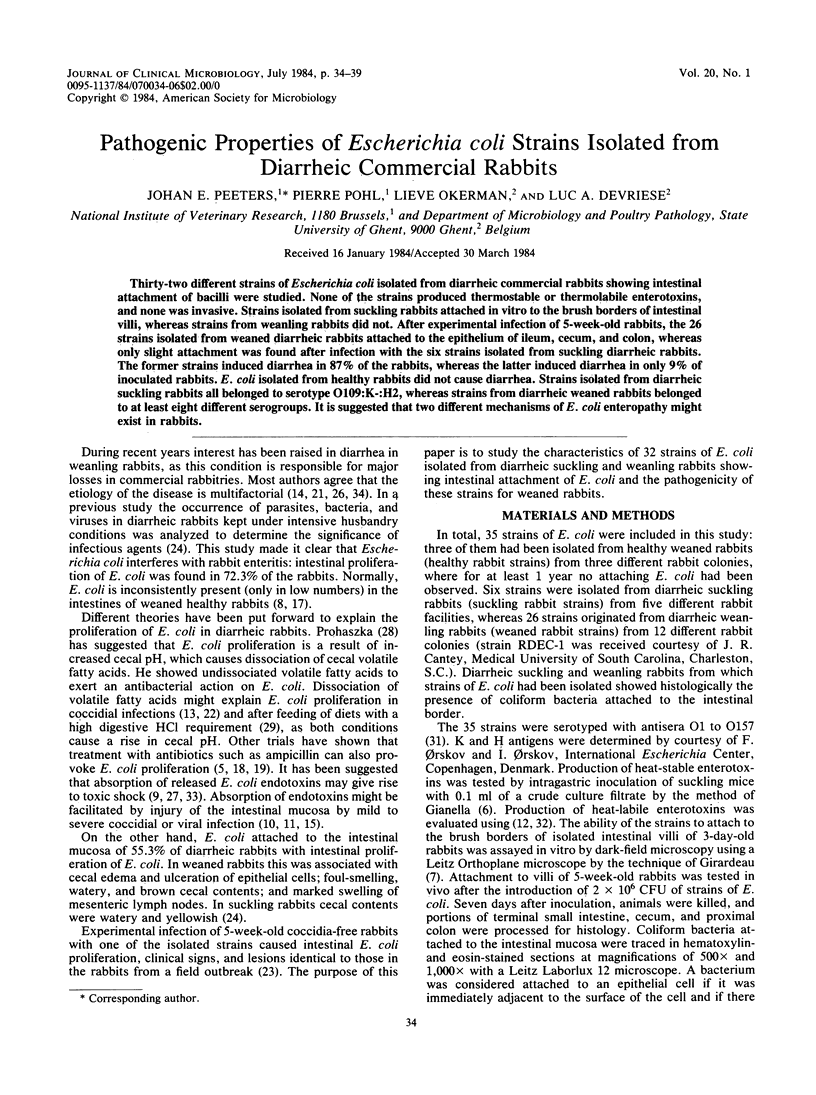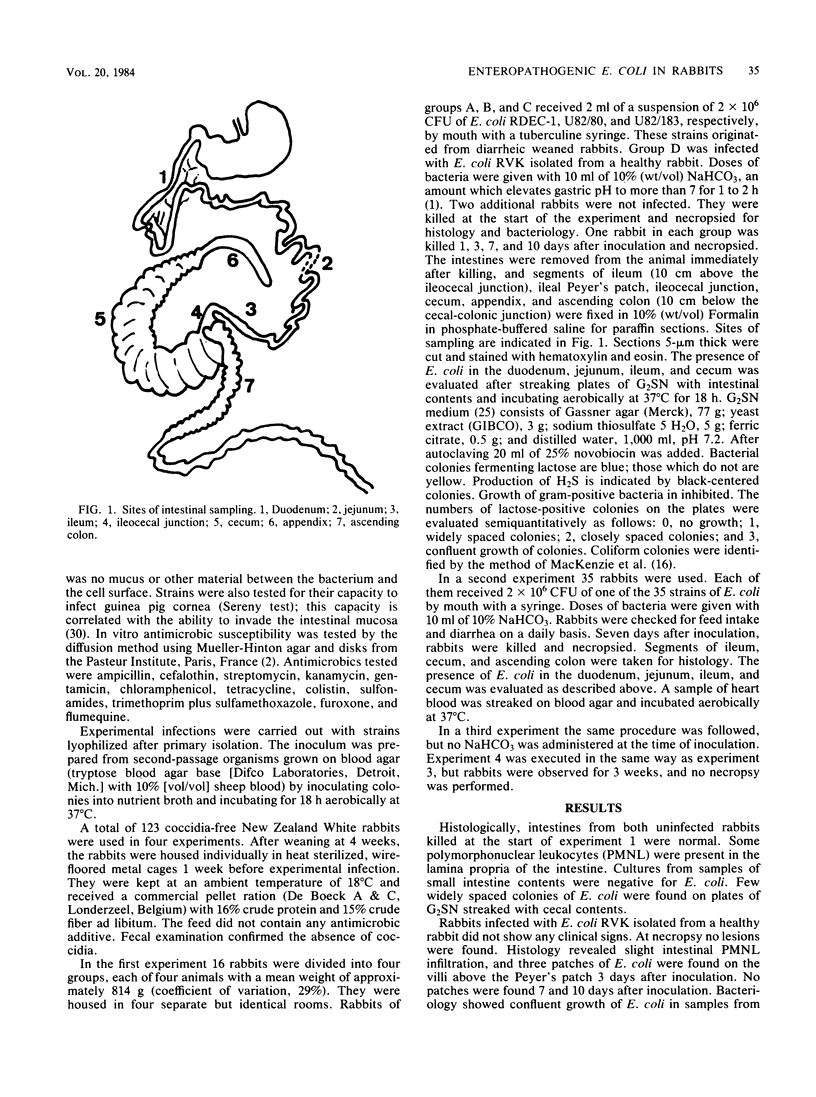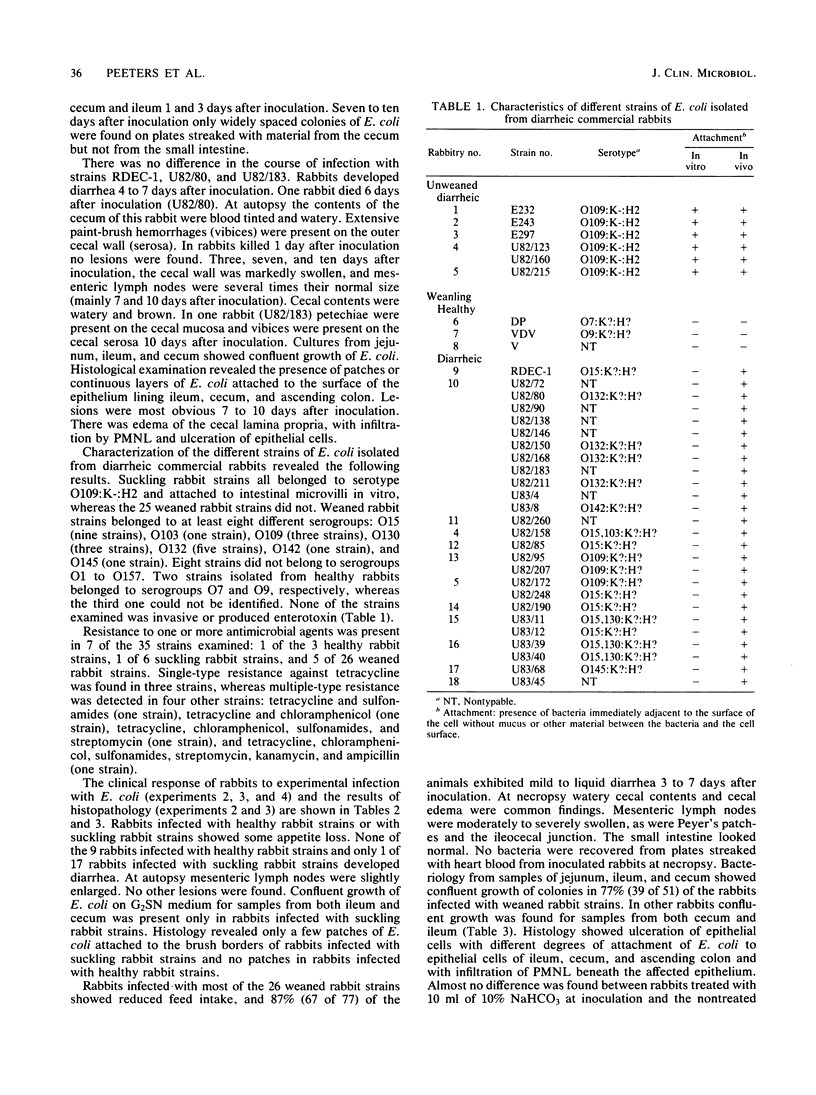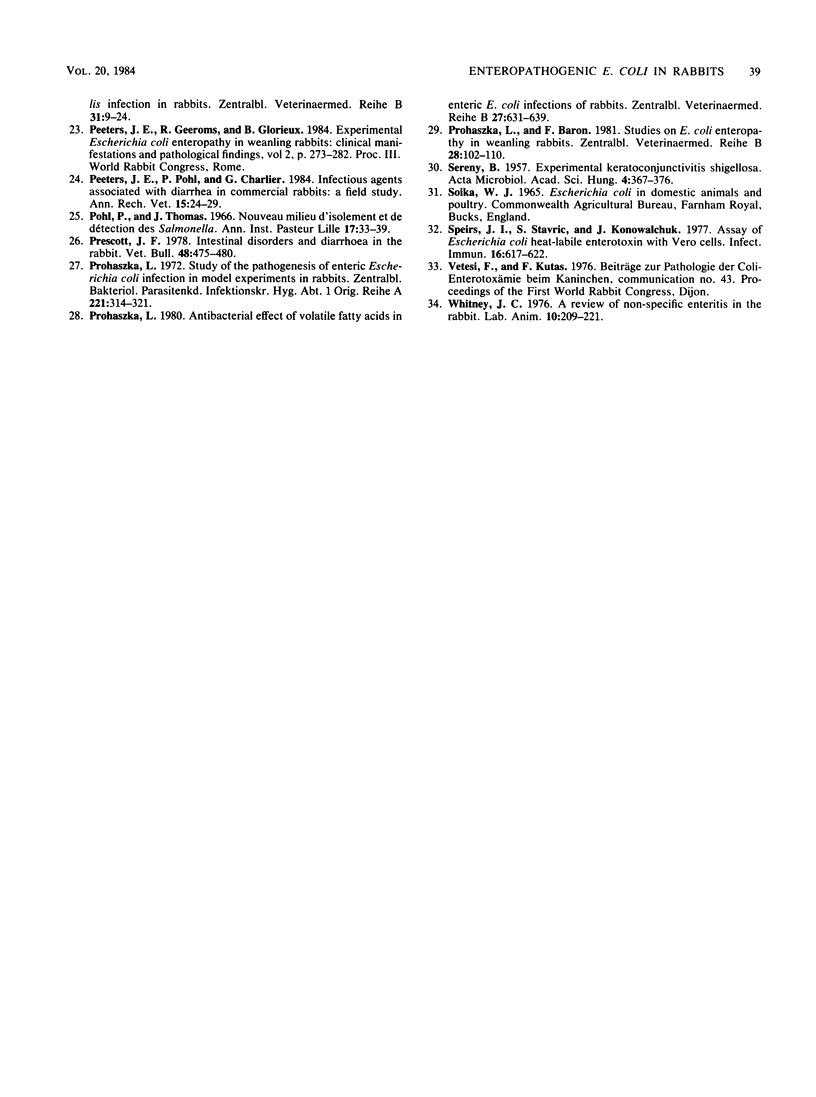Abstract
Thirty-two different strains of Escherichia coli isolated from diarrheic commercial rabbits showing intestinal attachment of bacilli were studied. None of the strains produced thermostable or thermolabile enterotoxins, and none was invasive. Strains isolated from suckling rabbits attached in vitro to the brush borders of intestinal villi, whereas strains from weanling rabbits did not. After experimental infection of 5-week-old rabbits, the 26 strains isolated from weaned diarrheic rabbits attached to the epithelium of ileum, cecum, and colon, whereas only slight attachment was found after infection with the six strains isolated from suckling diarrheic rabbits. The former strains induced diarrhea in 87% of the rabbits, whereas the latter induced diarrhea in only 9% of inoculated rabbits. E. coli isolated from healthy rabbits did not cause diarrhea. Strains isolated from diarrheic suckling rabbits all belonged to serotype O109:K-:H2, whereas strains from diarrheic weaned rabbits belonged to at least eight different serogroups. It is suggested that two different mechanisms of E. coli enteropathy might exist in rabbits.
Full text
PDF





Selected References
These references are in PubMed. This may not be the complete list of references from this article.
- Cantey J. R., Blake R. K. Diarrhea due to Escherichia coli in the rabbit: a novel mechanism. J Infect Dis. 1977 Mar;135(3):454–462. doi: 10.1093/infdis/135.3.454. [DOI] [PubMed] [Google Scholar]
- Donta S. T., Moon H. W., Whipp S. C. Detection of heat-labile Escherichia coli enterotoxin with the use of adrenal cells in tissue culture. Science. 1974 Jan 25;183(4122):334–336. doi: 10.1126/science.183.4122.334. [DOI] [PubMed] [Google Scholar]
- Escoula L., Camguilhem R., Larrieu G., More J. Sur la sensibilité du lapin a l'association ampicilline-gentamicine. Ann Rech Vet. 1981;12(1):11–17. [PubMed] [Google Scholar]
- Giannella R. A. Suckling mouse model for detection of heat-stable Escherichia coli enterotoxin: characteristics of the model. Infect Immun. 1976 Jul;14(1):95–99. doi: 10.1128/iai.14.1.95-99.1976. [DOI] [PMC free article] [PubMed] [Google Scholar]
- Girardeau J. P. A new in vitro technique for attachment to intestinal villi using enteropathogenic Escherichia coli. Ann Microbiol (Paris) 1980 Jul-Aug;131B(1):31–37. [PubMed] [Google Scholar]
- Hoffmann R., Hoffmann-Fezer G., Weber A. Pathologisch-histologische Befunde bei experimenteller Dysenterie der Jungkaninchen. Berl Munch Tierarztl Wochenschr. 1973 May 1;86(9):167–171. [PubMed] [Google Scholar]
- Hoffmann R., Hoffmann-Fezer G., Weber A. Untersuchungen zur Pathogenese der Dysenterie bei Jungkaninchen. I. Disseminierte intravasale Gerinnung bei experimenteller Dysenterie. Z Versuchstierkd. 1973;15(1):50–58. [PubMed] [Google Scholar]
- Konowalchuk J., Speirs J. I., Stavric S. Vero response to a cytotoxin of Escherichia coli. Infect Immun. 1977 Dec;18(3):775–779. doi: 10.1128/iai.18.3.775-779.1977. [DOI] [PMC free article] [PubMed] [Google Scholar]
- Matthes S. Die Darmflora gesunder und dysenteriekranker Jungkaminchen. Zentralbl Veterinarmed B. 1969 Aug 6;16(6):563–570. [PubMed] [Google Scholar]
- OSTLER D. C. The diseases of broiler rabbits. Vet Rec. 1961 Nov 25;73:1237–1254. [PubMed] [Google Scholar]
- Peeters J. E., Charlier G., Antoine O., Mammerickx M. Clinical and pathological changes after Eimeria intestinalis infection in rabbits. Zentralbl Veterinarmed B. 1984 Feb;31(1):9–24. doi: 10.1111/j.1439-0450.1984.tb01275.x. [DOI] [PubMed] [Google Scholar]
- Pohl P., Thomas J. Nouveau milieu d'isolement et de detection des Salmonella. Ann Inst Pasteur Lille. 1966;17:33–39. [PubMed] [Google Scholar]
- Prohászka L. Antibacterial effect of volatile fatty acids in enteric E. coli-infections of rabbits. Zentralbl Veterinarmed B. 1980;27(8):631–639. doi: 10.1111/j.1439-0450.1980.tb01726.x. [DOI] [PubMed] [Google Scholar]
- Prohászka L., Baron F. Studies on E. coli-enteropathy in weanling rabbits. Zentralbl Veterinarmed B. 1981;28(2):102–110. doi: 10.1111/j.1439-0450.1981.tb01744.x. [DOI] [PubMed] [Google Scholar]
- Prohászka L. Study of pathogenesis of enteric Escherichia coli infection in model experiments on rabbits. Zentralbl Bakteriol Orig A. 1972 Aug;221(3):314–321. [PubMed] [Google Scholar]
- SERENY B. Experimental keratoconjunctivitis shigellosa. Acta Microbiol Acad Sci Hung. 1957;4(4):367–376. [PubMed] [Google Scholar]
- Speirs J. I., Stavric S., Konowalchuk J. Assay of Escherichia coli heat-labile enterotoxin with vero cells. Infect Immun. 1977 May;16(2):617–622. doi: 10.1128/iai.16.2.617-622.1977. [DOI] [PMC free article] [PubMed] [Google Scholar]
- Whitney J. C. A review of non-specific enteritis in the rabbit. Lab Anim. 1976 Jul;10(3):209–221. doi: 10.1258/002367776781035305. [DOI] [PubMed] [Google Scholar]


